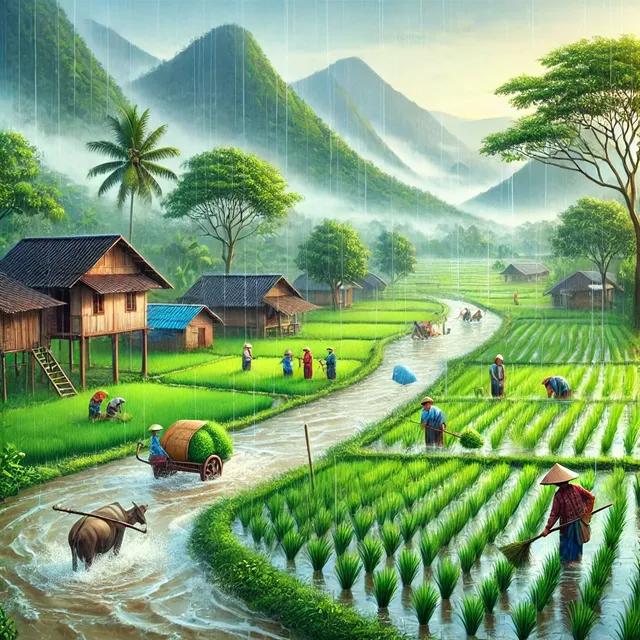🌧️ The Dual Impact of Monsoon: Destruction and Happiness for Farmers 🌾

The monsoon season is a vital part of life in South Asia, bringing both blessings and challenges. Countries like Nepal, India, Bangladesh, and Bhutan experience significant agricultural and socio-economic impacts due to the seasonal rains. While monsoons are crucial for farming, providing much-needed water for crops, they can also cause devastating floods and landslides. This article explores the dual nature of monsoons, highlighting both the joy and destruction they bring to farmers in these regions.
🌿 The Blessings of Monsoon
Monsoon rains are essential for agriculture in South Asia. The arrival of the monsoon season marks the beginning of the primary agricultural cycle, providing the water necessary for growing staple crops such as rice, maize, and millet.
🇮🇳 India: A Lifeline for Farmers
In India, the monsoon is often referred to as the "real finance minister." Around 70% of the country’s annual rainfall occurs during this season, which is crucial for the kharif crops. For example, in the states of Punjab and Haryana, the monsoon rains replenish groundwater levels and fill reservoirs, ensuring farmers have sufficient water for irrigation.
🇳🇵 Nepal: Sustaining Paddy Cultivation
In Nepal, paddy fields in the Terai region heavily depend on monsoon rains. The timely arrival of monsoon rains can lead to a bountiful harvest, boosting the country's economy and ensuring food security. The monsoon rains also support the growth of other crops such as maize and vegetables, which are essential for local diets.
🇧🇩 Bangladesh: Ensuring Food Security
Bangladesh, with its extensive river delta, benefits from the monsoon through the replenishment of water bodies and aquifers. The monsoon season is vital for the cultivation of rice, which is the staple food for the population. Adequate rainfall during this period can lead to a good harvest, ensuring food security for millions.
🇧🇹 Bhutan: Enhancing Agricultural Productivity
In Bhutan, monsoon rains are crucial for agriculture, particularly for rice and maize cultivation. The rains not only support crop growth but also help in maintaining the health of forests and pastures, which are essential for livestock farming.
🌊 The Destructive Side of Monsoon
While monsoons bring much-needed water for agriculture, they also pose significant challenges. The heavy rains can lead to floods, landslides, and other natural disasters, causing widespread destruction.
🇮🇳 India: Devastating Floods
In India, states like Assam and Bihar experience severe flooding almost every monsoon season. In 2020, floods in Assam affected over 5 million people, damaging crops, homes, and infrastructure. The loss of crops can be catastrophic for farmers who depend on their yield for their livelihood.
🇳🇵 Nepal: Landslides and Floods
Nepal faces a high risk of landslides and floods during the monsoon season. In 2021, heavy rains triggered landslides and floods in several districts, causing loss of life and property. Farmers often face the challenge of their fields being washed away, leading to food shortages and economic hardship.
🇧🇩 Bangladesh: Riverbank Erosion
In Bangladesh, the Brahmaputra and Ganges rivers swell during the monsoon, leading to severe riverbank erosion. This erosion displaces thousands of families annually, destroying homes and farmland. The 2019 monsoon floods affected over 7.6 million people, highlighting the vulnerability of the region.
🇧🇹 Bhutan: Infrastructure Damage
Bhutan's mountainous terrain makes it particularly susceptible to landslides and flash floods during the monsoon. In 2020, landslides triggered by monsoon rains caused significant damage to roads and bridges, disrupting the transportation of goods and affecting farmers' ability to sell their produce.
⚖️ Balancing the Dual Impact
The governments and communities in these countries take various measures to mitigate the destructive impacts of the monsoon while maximizing its benefits. Improved forecasting, better infrastructure, and community awareness programs are crucial in managing the dual impact of the monsoon season.
🇮🇳 India: Technological Advancements
India has invested in better weather forecasting systems to predict monsoon patterns accurately. Additionally, building and maintaining flood-resistant infrastructure, such as embankments and drainage systems, helps mitigate the impact of floods.
🇳🇵 Nepal: Community-Based Programs
Nepal focuses on community-based disaster risk reduction programs, teaching farmers sustainable farming practices and how to prepare for floods and landslides. This approach helps reduce the vulnerability of rural communities.
🇧🇩 Bangladesh: Flood Management
Bangladesh has implemented extensive flood management programs, including the construction of flood shelters and the development of early warning systems. These measures aim to protect lives and livelihoods during the monsoon season.
🇧🇹 Bhutan: Sustainable Practices
Bhutan emphasizes sustainable land management practices to prevent soil erosion and landslides. Terracing, afforestation, and the construction of check dams are some of the measures used to protect farmland and infrastructure.
📝 Conclusion
The monsoon season in South Asia is a double-edged sword, bringing both blessings and destruction. For farmers in Nepal, India, Bangladesh, and Bhutan, the rains are essential for their crops but also pose significant risks. Balancing the benefits of the monsoon with effective disaster management strategies is crucial for ensuring the well-being and prosperity of these agricultural communities. Through improved infrastructure, better forecasting, and community-based programs, these countries can harness the power of the monsoon while minimizing its destructive impacts.
Congratulations, your post has been upvoted by @upex with a 55.12% upvote. We invite you to continue producing quality content and join our Discord community here. Visit https://botsteem.com to utilize usefull and productive automations #bottosteem #upex
Downvoting a post can decrease pending rewards and make it less visible. Common reasons:
Submit